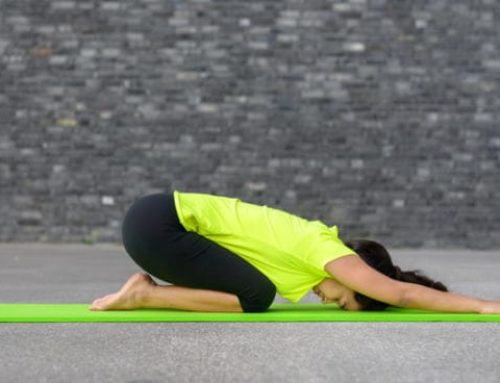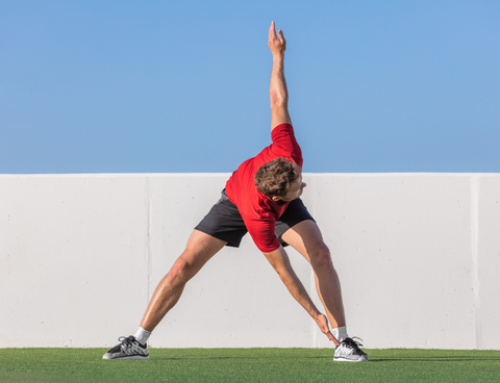9 Exercises That Improve Spinal Health
![]()
Back pain can be debilitating to the point where you’re unable to do anything, let alone participate in sports. About 80 percent of people experience back pain in some capacity at some point in their lives. This can range from minor aches (like you get because you overdid something) to sharp pains and structural deformities. Poor spinal health results from lack of mobility and stability, bad movement habits, core weakness, and just not moving enough.
The spine is made up of four segments: the cervical, thoracic and lumbar vertebrae, and the sacrum. Each has a particular role in spinal health. For instance, the thoracic spine should be mobile, and the lumbar spine should maintain stability. However, when they flip roles, compensation patterns and bad movement habits occur, which can lead to spinal health being compromised.
To maintain and promote spinal health, training the body in the correct manner is of the utmost importance, and it all starts with relearning and re-grooving movements. Core strength could be at the top of the list, but if your movement patterns are of poor quality, it doesn’t matter how great your core strength and endurance are, you’re going to end up hurt.
Once movement patterns are cleaned up, you can move on to training your core to perform its true role—resisting movement. Core training isn’t just about developing rock-solid abs. It is vital to maintaining spinal health. If that’s what you’re looking to do, add these exercises into your program.
Mobility
Two areas of the body that tend to get locked up and increase the risk to how the spine works are the thoracic spine and the hips. The thoracic spine can lose mobility in extension and through rotation. The following two thoracic spine drills are perfect to alleviate both. The third mobility drill tackles internal and external rotation through the hips. Due to a lifestyle of sitting, the hips can develop tension, which leads to a lack of mobility. Imagine trying to squat without having a requisite amount of mobility through the hips. You can’t. You just end up developing it from other parts of your body.
Thoracic Extension
- Lie on the ground with a double lacrosse ball toward the top/middle of your back.
- Brace your core slightly.
- Bring your arms from your sides to over your head and reach as far back as you can while maintaining rib position.
- Return to start.
Thoracic Rotation
- Start in a quadruped position, hands under shoulders, knees under hips.
- Place one hand behind your head.
- Bring your elbow and shoulder down toward the floor and to your opposite arm.
- Brace and avoid and shifting your body.
- Return to start.
90/90 Switches
- Sit on the ground with one leg in front, bent at 90 degrees, and the other to the side, also at 90. Line your front heel up with the knee of your opposite leg.
- This puts one hip in external rotation and the other in internal rotation.
- Keep your feet planted and transfer your knees to the opposite side—i.e., “switch” positions.
- Make sure to keep your chest up and core engaged.
Strength and Endurance
Bird Dog
The Bird Dog is a great exercise for strength/endurance of the back extensors under zero load and rotary stability through the core.
- Start in a quadruped position and brace your core.
- Slowly extend your left arm and right leg, making sure to maintain a neutral spine.
- Switch sides.
- Return to starting position.
Side Plank or Anti-Lateral Flexion
The lumbar spine is limited to about 24 degrees of lateral flexion. Anything beyond that can compromise spinal health. Performing anti-lateral flexion exercises like the Side Plank can help avoid that. Other variations include Offset Carries, Vertical Pallof Presses, and Suitcase Carries.
- Lie on one side with your legs straight and an elbow underneath the shoulder.
- Push your body up, maintaining a straight line from shoulders to feet.
- Engage your core and glute, and hold for prescribed amount of time or number of breaths.
Dead Bug or Anti-Extension
Sustaining a neutral spine is all about keeping a “ribs over hips” position. This is crucial for any exercise. Training this movement, or lack thereof, keeps the spine from reaching a hyperextended position, which can put pressure on discs. Exercises like the Dead Bug and Plank are great additions to your program.
- Lie on your back with you knees over your hips and extend your arms from the shoulders.
- Brace your core, making sure your back stays flat to the ground, and slowly lower one arm and the opposite leg.
- Exhale as your arm and leg come down toward the ground.
- As the leg lowers, prevent the pelvis from rolling.
- Return to start.
Wide-Stance Anti-Rotation Chop or Anti-Rotation
One last aspect to controlling spinal movement is preventing rotation. The lumbar spine has about 2-5 degrees of rotation. That’s not a lot of movement. The thoracic spine has a lot more available movement. Remember, the thoracic spine should be mobile. The exercise above trains the body to dissociate T-spine rotation from lumbar rotation. It becomes a challenging anti-rotation + T-spine mobility exercise. For athletes who play any sort of rotational sport, anti-rotation exercises should be a staple movement. Another variation of an anti-rotation exercise is the Pallof Press.
- Take a wide stance and hold a band in front of your chest with your arms extended.
- Rotate your upper body toward the anchor of the band, as far as your range of motion allows.
- Make sure the rotation comes from your thoracic spine and not your lower body.
- Return to the starting position by rotating your upper body using your core musculature, not your arms and shoulders.
- Continue rotating your torso in each direction.
Hip Thrust
Glute strength plays a big part in how your back functions. Weak or inactive glutes force the body to make up the difference elsewhere. For instance, when deadlifting, there’s a big difference between finishing with the glutes and hips and finishing with a hyperextended lumbar spine. Also, the glutes work as a pelvic stabilizer, leading to better spinal stability.
- Place your shoulder blades against a bench, and either outstretch your arms or spread them across your chest for stability.
- Bend your knees to about 90 degrees and plant your feet flat on the floor.
- Brace your core, squeeze your glutes and lift your hips up toward the ceiling. Avoid hyperextension of the low back at the top.
- Bring your hips back down, making sure to avoid pelvic rolling and ribs flaring.
Sorenson Plank
Among the myriad of reasons why back pain can occur is that the lumbar extensors lack strength; but more significant is lack of endurance. If the back muscles can’t produce or resist force, the body relies on other areas to pick up the slack. The Sorenson Plank or Sorenson Test is meant to determine how much endurance your back has.
- Set up prone in the glute-ham raise machine with your legs straight and hips slightly in front of the pads.
- Hold your body horizontally for a designated amount of time or for as long as you can.
When it comes to the health of your spine, remember this saying: “Move well, then move often.”
READ MORE:
[cf]skyword_tracking_tag[/cf]RECOMMENDED FOR YOU
MOST POPULAR
9 Exercises That Improve Spinal Health
![]()
Back pain can be debilitating to the point where you’re unable to do anything, let alone participate in sports. About 80 percent of people experience back pain in some capacity at some point in their lives. This can range from minor aches (like you get because you overdid something) to sharp pains and structural deformities. Poor spinal health results from lack of mobility and stability, bad movement habits, core weakness, and just not moving enough.
The spine is made up of four segments: the cervical, thoracic and lumbar vertebrae, and the sacrum. Each has a particular role in spinal health. For instance, the thoracic spine should be mobile, and the lumbar spine should maintain stability. However, when they flip roles, compensation patterns and bad movement habits occur, which can lead to spinal health being compromised.
To maintain and promote spinal health, training the body in the correct manner is of the utmost importance, and it all starts with relearning and re-grooving movements. Core strength could be at the top of the list, but if your movement patterns are of poor quality, it doesn’t matter how great your core strength and endurance are, you’re going to end up hurt.
Once movement patterns are cleaned up, you can move on to training your core to perform its true role—resisting movement. Core training isn’t just about developing rock-solid abs. It is vital to maintaining spinal health. If that’s what you’re looking to do, add these exercises into your program.
Mobility
Two areas of the body that tend to get locked up and increase the risk to how the spine works are the thoracic spine and the hips. The thoracic spine can lose mobility in extension and through rotation. The following two thoracic spine drills are perfect to alleviate both. The third mobility drill tackles internal and external rotation through the hips. Due to a lifestyle of sitting, the hips can develop tension, which leads to a lack of mobility. Imagine trying to squat without having a requisite amount of mobility through the hips. You can’t. You just end up developing it from other parts of your body.
Thoracic Extension
- Lie on the ground with a double lacrosse ball toward the top/middle of your back.
- Brace your core slightly.
- Bring your arms from your sides to over your head and reach as far back as you can while maintaining rib position.
- Return to start.
Thoracic Rotation
- Start in a quadruped position, hands under shoulders, knees under hips.
- Place one hand behind your head.
- Bring your elbow and shoulder down toward the floor and to your opposite arm.
- Brace and avoid and shifting your body.
- Return to start.
90/90 Switches
- Sit on the ground with one leg in front, bent at 90 degrees, and the other to the side, also at 90. Line your front heel up with the knee of your opposite leg.
- This puts one hip in external rotation and the other in internal rotation.
- Keep your feet planted and transfer your knees to the opposite side—i.e., “switch” positions.
- Make sure to keep your chest up and core engaged.
Strength and Endurance
Bird Dog
The Bird Dog is a great exercise for strength/endurance of the back extensors under zero load and rotary stability through the core.
- Start in a quadruped position and brace your core.
- Slowly extend your left arm and right leg, making sure to maintain a neutral spine.
- Switch sides.
- Return to starting position.
Side Plank or Anti-Lateral Flexion
The lumbar spine is limited to about 24 degrees of lateral flexion. Anything beyond that can compromise spinal health. Performing anti-lateral flexion exercises like the Side Plank can help avoid that. Other variations include Offset Carries, Vertical Pallof Presses, and Suitcase Carries.
- Lie on one side with your legs straight and an elbow underneath the shoulder.
- Push your body up, maintaining a straight line from shoulders to feet.
- Engage your core and glute, and hold for prescribed amount of time or number of breaths.
Dead Bug or Anti-Extension
Sustaining a neutral spine is all about keeping a “ribs over hips” position. This is crucial for any exercise. Training this movement, or lack thereof, keeps the spine from reaching a hyperextended position, which can put pressure on discs. Exercises like the Dead Bug and Plank are great additions to your program.
- Lie on your back with you knees over your hips and extend your arms from the shoulders.
- Brace your core, making sure your back stays flat to the ground, and slowly lower one arm and the opposite leg.
- Exhale as your arm and leg come down toward the ground.
- As the leg lowers, prevent the pelvis from rolling.
- Return to start.
Wide-Stance Anti-Rotation Chop or Anti-Rotation
One last aspect to controlling spinal movement is preventing rotation. The lumbar spine has about 2-5 degrees of rotation. That’s not a lot of movement. The thoracic spine has a lot more available movement. Remember, the thoracic spine should be mobile. The exercise above trains the body to dissociate T-spine rotation from lumbar rotation. It becomes a challenging anti-rotation + T-spine mobility exercise. For athletes who play any sort of rotational sport, anti-rotation exercises should be a staple movement. Another variation of an anti-rotation exercise is the Pallof Press.
- Take a wide stance and hold a band in front of your chest with your arms extended.
- Rotate your upper body toward the anchor of the band, as far as your range of motion allows.
- Make sure the rotation comes from your thoracic spine and not your lower body.
- Return to the starting position by rotating your upper body using your core musculature, not your arms and shoulders.
- Continue rotating your torso in each direction.
Hip Thrust
Glute strength plays a big part in how your back functions. Weak or inactive glutes force the body to make up the difference elsewhere. For instance, when deadlifting, there’s a big difference between finishing with the glutes and hips and finishing with a hyperextended lumbar spine. Also, the glutes work as a pelvic stabilizer, leading to better spinal stability.
- Place your shoulder blades against a bench, and either outstretch your arms or spread them across your chest for stability.
- Bend your knees to about 90 degrees and plant your feet flat on the floor.
- Brace your core, squeeze your glutes and lift your hips up toward the ceiling. Avoid hyperextension of the low back at the top.
- Bring your hips back down, making sure to avoid pelvic rolling and ribs flaring.
Sorenson Plank
Among the myriad of reasons why back pain can occur is that the lumbar extensors lack strength; but more significant is lack of endurance. If the back muscles can’t produce or resist force, the body relies on other areas to pick up the slack. The Sorenson Plank or Sorenson Test is meant to determine how much endurance your back has.
- Set up prone in the glute-ham raise machine with your legs straight and hips slightly in front of the pads.
- Hold your body horizontally for a designated amount of time or for as long as you can.
When it comes to the health of your spine, remember this saying: “Move well, then move often.”
READ MORE:
[cf]skyword_tracking_tag[/cf]









